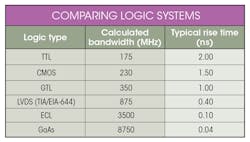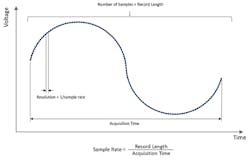Download this article in PDF format.
An oscilloscope is used to measure the voltage change of a signal over time. After a digital multimeter, an oscilloscope is typically the second most common piece of equipment found on an electronic test bench. This article is intended to help you learn the basics of oscilloscope functions and specs, and how to go about selecting the best scope for your application. We also provide an overview of the specifications we used when determining our picks for the best oscilloscopes.
At the end of this article you will find links to specific oscilloscope reviews based on maximum bandwidth. While bandwidth is typically the first specification people consider, you should also look at the sample rate, maximum memory depth, waveform update, resolution, and accuracy to fully understand what type of signal the oscilloscope is best suited to measure.
If you’re new to electronics and trying to learn how to use an oscilloscope, I would highly recommend this article by Sparkfun. The article gives a good overview of the basics of oscilloscopes, the typical lexicon of an oscilloscope, and how to use them properly.
How to Select the Best Oscilloscope
First, you should understand the type of signal you will be measuring. Are you troubleshooting an analog system with sine waves, or digital systems with short TTL pulses? Are you looking for a fast-intermittent peak? What’s the expected voltage range and frequency of the signal you intend to measure?
When reviewing a manufacturer’s specification for a particular function, it’s important to understand how the specification was determined. If it’s a high-quality scope, there are usually plenty of footnotes on the datasheet explaining how a specification was derived and/or measured. It's also important to understand if the specification is measured and calibrated during manufacturing. For critical specifications in your application, we recommend you steer clear of the word “typical” in the spec table.
What is Bandwidth in an Oscilloscope?
The bandwidth of an oscilloscope is typically defined as the maximum frequency the oscilloscope can measure without significant distortion caused by the front-end amplifiers. Most oscilloscope manufacturers specify this at the 3-dB point that corresponds to about a 30% loss in amplitude.
Understanding this limitation leads many engineers to use the “rule of five” when determining the correct oscilloscope bandwidth for their application. Essentially, this means that if you have a 100-MHz signal you want to measure, you will want to use a 500-MHz oscilloscope to ensure that you’re properly capturing and measuring the signal. The bandwidth of the oscilloscope also tells you the rise time that the oscilloscope can measure.
The table provides the typical bandwidth and rise times for different logic systems.
Oscilloscope Sample Rate
The sample rate of a scope determines how many data points you will have for your measured waveform (see figure). At a minimum, it’s recommended that you have at least two times the sample rate of the waveform you’re trying to measure. To be sure that you find any transient events in the waveform, it’s better to have four to five times the required sample rate.
The sample rate should be significantly higher than the frequency of any sample waveform to be examined.
Sample rate is typically specified as Gsample/s (gigasamples per second) or Msample/s (megasamples per second). Most oscilloscope specifications give two different max sample rates. The first (typically a larger sample rate) assumes you’re using half of the available channels. The second assumes all channels are used, which means if you’re only using one channel of a two-channel scope, you will have a higher sampling rate.
Max Memory Depth
To be able to view and/or analyze your signal, not only do you need to have the correct bandwidth and sample rate, you need enough memory to store the signal. Manufacturers specify memory as Max Memory Depth. This is typically specified in Mpoints or kpoints. Simple right? Select the largest Max Memory Depth and you’re set. This is partially true, though.
The oscilloscope needs to have the processing power to store the signal and retrieve it for display on the screen. So, if you’re trying to debug a digital system with a small glitch, you will need to dig deeper to ensure the oscilloscope will catch this glitch and allow you to start the fun work of debugging.
Waveform Update Rate
An oscilloscope waveform update rate defines how quickly the acquired signal can be processed, be sent to the screen, and then restart the acquisition. The waveform update rate is specified in Wfms/s (waveforms per second). Processing time is essentially "dead time" when the scope isn’t measuring your signal. Therefore, you will need to ensure that your scope waveform update rate matches the signal you expect to measure.
Other Considerations
Other factors we used when reviewing and selecting the best oscilloscopes included resolution and the accuracy of the measurements. We also considered how easy the oscilloscope was to use, and how intuitive the front panel seemed when it came to finding the key functions. A robust set of measurements available on the oscilloscope will make the engineer’s job easier when troubleshooting or testing of the circuit.
Besides the layout of the front panel, we also considered the screen size. Large high-resolution screens make it easier to display multiple measurements and find those troublesome transient signals.
Steve Gwinner is CEO of Laser Lab Source.



